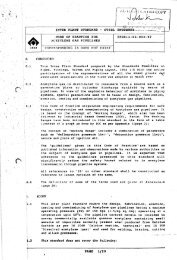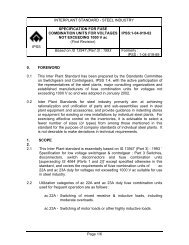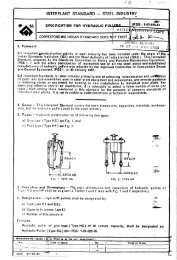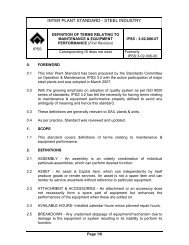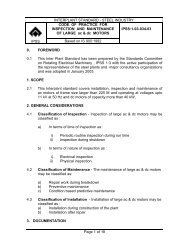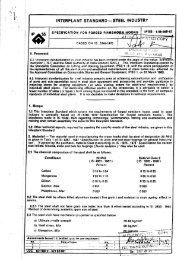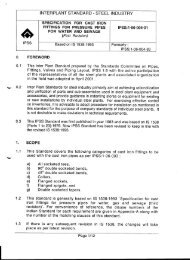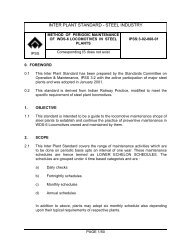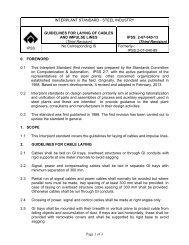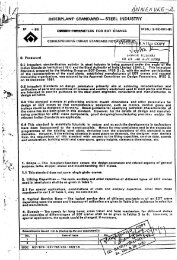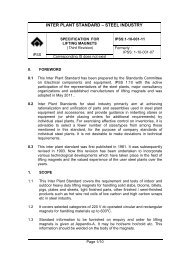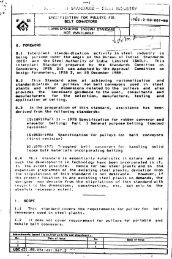Code of practice for overhauling of dc motors with anti-friction/sliding ...
Code of practice for overhauling of dc motors with anti-friction/sliding ...
Code of practice for overhauling of dc motors with anti-friction/sliding ...
You also want an ePaper? Increase the reach of your titles
YUMPU automatically turns print PDFs into web optimized ePapers that Google loves.
IPSS:1-03-033-03<br />
4.2.7 In the case <strong>of</strong> split type <strong>of</strong> field body the top half and the armature is lifted<br />
one after the another and placed in suitable location <strong>for</strong> further jobs. The<br />
top half should be suitably placed so that access to cleaning/repairing is<br />
available.<br />
4.3 Dismantling <strong>of</strong> <strong>motors</strong> <strong>with</strong> <strong>sliding</strong> bearings<br />
4.3.1 Remove thermometer and oil pipeline connection to <strong>sliding</strong> bearings.<br />
5. POST-DISMANTLING CHECKS AND REPAIRS - Clean the armature and<br />
field thoroughly, first by blowing <strong>with</strong> dry and clean compressed air & suitable<br />
cleaning agent or putting under vaccum where such facility exists, and then<br />
<strong>with</strong> a suitable cleaning agent to remove dust, oil and grease. In the mean<br />
time, look <strong>for</strong> any abnormality both in the armature as well as in the field<br />
body, viz, broken/missing wedges, dry solders in risers, looseness in banding,<br />
cracks in armature equalizer connections, cracks in insulators, etc and rectify.<br />
Minor repairs <strong>of</strong> these nature is to be done be<strong>for</strong>e it is put to oven / heat<br />
chamber <strong>for</strong> drying. If it is possible, it should be allowed to dry in furnace <strong>for</strong> a<br />
required duration to stabalize desired IR value at the specified temperature as<br />
per class <strong>of</strong> insulation. In case the dirt is too much, sometimes it is preferred<br />
to heat the armature & field be<strong>for</strong>e actual cleaning <strong>of</strong> armature upto a safe<br />
value is done.<br />
5.1 Armature<br />
5.1.1 Take the beating <strong>of</strong> coupling shaft.<br />
5.1.2 Carry out mica undercutting and bevelling <strong>of</strong> commutator.<br />
5.1.3 Carry out DROP TEST on commutator. If drop across certain pair <strong>of</strong><br />
segments are high (greater than 5%), these are to be resoldered, cleaned<br />
thoroughly & rechecked. If the drop is low (less than 5%) then those<br />
segments are to be thoroughly cleaned by a cleaning agent, dried & redroptested<br />
(Segments showing variation in drop test more than +5% / -5%<br />
upto a maximum limit <strong>of</strong> 5% <strong>of</strong> total commutator bars spread over the<br />
circumference can be allowed).<br />
5.1.4 Check condition <strong>of</strong> wedges, coil insulation and bandages. If the wedges<br />
are bad, it should be changed. If the banding is not proper it should be<br />
replaced. If coils are damaged, repair or replace them. For banding<br />
purpose, resiglass banding tapes may be used <strong>with</strong> suitable no. <strong>of</strong> turns.<br />
Banding tape curing is to be done at a particular temperature & <strong>for</strong> a<br />
specified time as prescribed in the brochure.<br />
5.1.5 Check the Condition <strong>of</strong> Bearings :<br />
5.1.5.1 In case <strong>of</strong> motor <strong>with</strong> <strong>anti</strong><strong>friction</strong> bearing, check the condition <strong>of</strong><br />
bearings and their tightness on shaft. If loose, the damaged bearing<br />
Page 4 <strong>of</strong> 9




